In March 2017, Berlin police raided the studio of artist Julian Charrière to confiscate a one-ton cannon designed to fire radioactive coconuts. The story made headlines around the world for its absurdity—a man walking his dog claimed he was almost struck by one of Charrière’s flying coconuts—but for the artist, the incident was no joke.
A reference to a Jules Verne novel about American industrialists who sought to access coal deposits under the North Pole with a cannon of their own, the sculpture was the artist’s contribution to the inaugural Antarctic Biennial. Charrière ended up submitting documentation of the cannon’s confiscation in lieu of the object itself.
Years later, the coconut episode stands as a kind of metaphor for Charrière’s practice. The artist, now 33, deploys a variety of media in his quest to examine the symbiotic relationship between modernity and Mother Nature—and how that relationship is mediated through images. It’s not environmental art, exactly—more like conceptual art in the age of the Anthropocene.
Often, Charrière hones in on the conflict between humanity’s hunger for progression and nature’s need to perpetuate its own existence. For his series First Light (2016), he developed dreamy landscape photos of Bikini Atoll (home to US nuclear tests in the 1940s and ’50s) with radioactive material. In Metamorphism (2016), the artist melted down computer scraps culled from laptops and smartphones into artificial lava, from which he created scabrous stone sculptures.
Charrière’s latest exhibition, “Towards No Earthly Pole,” on view through March 21 at Sean Kelly Gallery in New York, features a film of the same name in which a roving drone captures abstracted footage of glaciers in Antarctica and Europe. It is installed in the same gallery is a series of sculptures made from boulders displaced by glacial ice, which the artist found in otherwise empty fields. To create the sculptures, Charrière drilled into the rocks and installed them atop a bed of the samples taken from their cores, evoking a kind of prehistoric assembly line.
Charrière spoke with Artnet News about the show, that notorious coconut cannon, and why people often misunderstand his work.
You’ve mentioned that the inspiration for this show came when you were preparing for the Antarctic Biennale in 2017. I want to start there. Can you tell me what your relationship to the region?
My relationship to the Arctic started in 2010 with my first trip to Iceland just after the eruption of the Eyjafjallajökull volcano. Three years later, I went back to realize a piece called Blue Fossil Entropic Stories for which I climbed an iceberg and tried to melt it down with a blow torch for almost eight hours. Photographs of me standing on the ice and trying to melt it down became a starting point for a longer dialogue with these regions. It was also my first attempt to reverse the romantic idea of separation between the observer and the surrounding world.
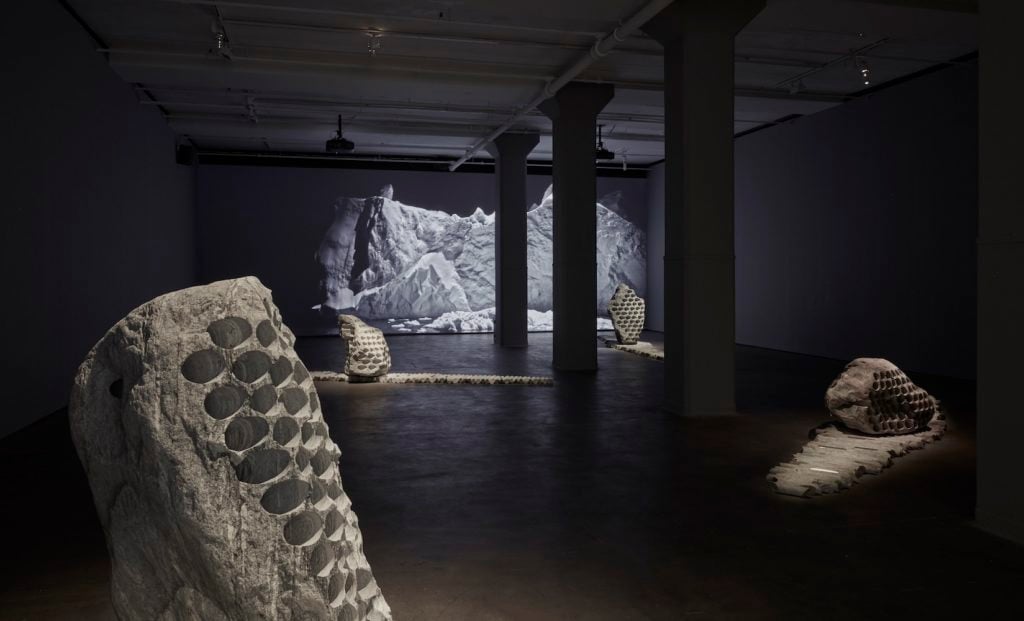
Installation shot of Julian Charrière’s “Towards No Earthly Pole,” Sean Kelly, 2020. Courtesy of Sean Kelly. Photo: Jason Wyche.
The Antarctic Biennale was an important moment in your career—though not, I imagine, for the reasons you may have originally predicted.
I designed a project related to a body of work I did on a former atomic test site on Bikini Atoll in the Marshall Islands. The idea was to build a cannon that would shoot a radioactive coconut from Bikini Atoll toward the South Pole. The coconut eventually would hit the ground and give birth to a new tree—that was the intention, at least. The idea was to embed this radioactive coconut in the ice, like a time bomb. To me, the coconut is an alienated seed, a by-product of the friction of the cultural and natural spheres—a forbidden fruit of western science. Coconuts have always been ambassadors of life and hope, but in this case, they became an ambiguous messenger.
The cannon was a reference to Jules Verne’s novel Sans dessus dessous, a story about an American secret society purchasing the North Pole. It’s a controversial fable about global warming and the proliferation of weapons of mass destruction. But I found it fascinating that, in 1889, a guy wrote a story about the United States purchasing the North Pole with the intention of melting it down to get to the raw material—petrol, coal, etc.—while putting half of the earth underwater in the process. The cannon was a kind of homage to Verne, but at the same time, it was also about creating a link between a sinking landscape—Bikini Island, which only has 50 years before it’s completely subsumed by water—and a melting one—the Antarctic Peninsula.
At the very end, the cannon was confiscated by the German police, so I was never able to realize the project in the way I intended to.
The incident made headlines around the world. Looking back, it’s kind of ironic.
The biennale did not exist in a tangible form for the general public; there were only artists on board [the ship that navigated the continent]. So it was interesting that the cannon got confiscated and the story went everywhere, from the New York Times to newspapers in Australia.
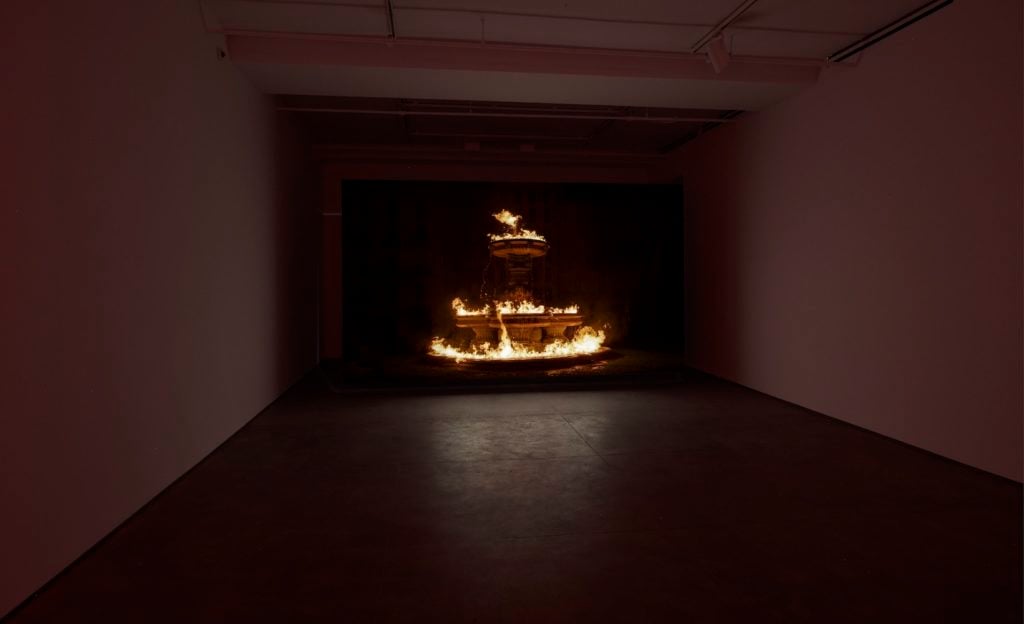
Installation shot of Julian Charrière’s “Towards No Earthly Pole,” Sean Kelly, 2020. Courtesy of Sean Kelly. Photo: Jason Wyche.
You also turned the documentation of the cannon’s confiscation into an artwork itself. I thought that moment was an interesting metaphor for your practice in general. How did that change or add to the ideas behind the original artwork?
The cannon was always meant to be a story, a myth. It was supposed to be brought there, to be shot, and then left in a whaling station on Desolation Island to erode. In a sense, the cannon was never the artwork; the artwork was meant to be the story that a coconut was shot toward the South Pole. And then it got confiscated, and the fictional aspect increased drastically. All these weird, fake stories from German newspapers spread about how an artist tried to shoot passerby, and so on. It became a fable that reached a much larger audience and made the whole story more significant, more complex.
But you still made the trip to Antarctica, correct? Is that when you conceived of your latest video on view at Sean Kelly, Towards No Earthly Pole?
Having the cannon confiscated also meant that I was out there on the boat with no work. I did a little performance—it was just an hour of silence—and the rest of the time I was helping my colleagues. But during the night, it was quite quiet, so I spent a lot of time staring at the landscape. Because radar and sonar systems are not 100 percent reliable in locating icebergs, there was a guy on the upper deck who was using a giant spotlight to search for them. All this technology and we were using this very analog way of scanning the emptiness of the polar night.
I was also thinking about this photo series by Frank Hurley. He was the photographer on Ernest Shackleton’s famous Antarctic expedition in 1914, where their boat froze and they became stranded on floating sheets of ice for 18 months, eating raw penguin and seals, before making it back to land. While stranded, Hurley made a photo series of the boats stuck in the ice. He used up to 30 mechanized flashes, creating this very strange kind of black-and-white stage photography. Because there was light all around the object, the photo looked very flat—it became almost like a scan. That’s what sparked me to film [glaciers] with the spotlight attached to a drone, a process that took two and a half years.
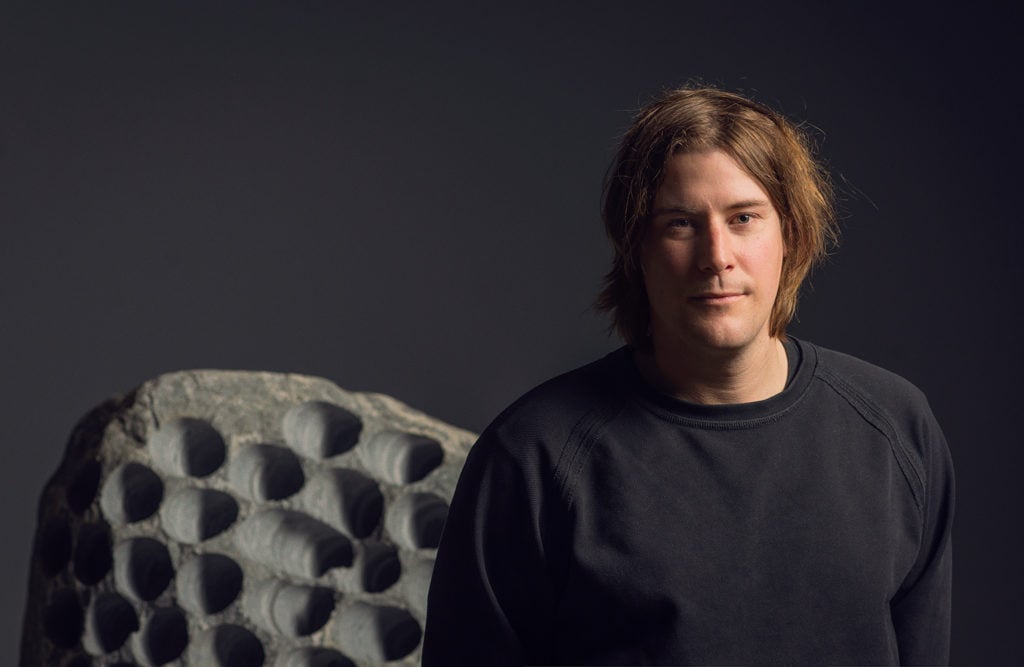
Julian Charrière, 2020. Photo: Taylor Dafoe.
That makes sense. It feels like the camera—and thus the viewer—is scanning the landscape in the film.
Over the past ten years, with Google Earth and then with the advent of drone technology, we’ve started to view things from beyond the perspective of a human being. We talk about drones as warfare technology, but it’s also interesting that they have changed the way we actually see our world and construct our realities. It’s a huge shift in visual culture.
The film features footage of Antarctica, Greenland, Iceland, and the Swiss Alps, but it’s cut together so that it appears as one continuous shot. There’s no sense of place or reference to location at all. Why did you choose to abstract the landscape in that way?
The film is addressing the way we construct our reality through images. If we look at a mountain, we probably all see the same mountain regardless of its specific characteristics, right? Because we all have the same background that makes us understand that it’s a mountain.
Interestingly, polar iconography is bound almost exclusively to scientific imagery. We know the South Pole because scientists shared pictures of it. It’s a collective imagination of geography, one that only exists through images that have been mediated through science. So for me, it was a question of, how can I trigger this idea of constructed geography through images?
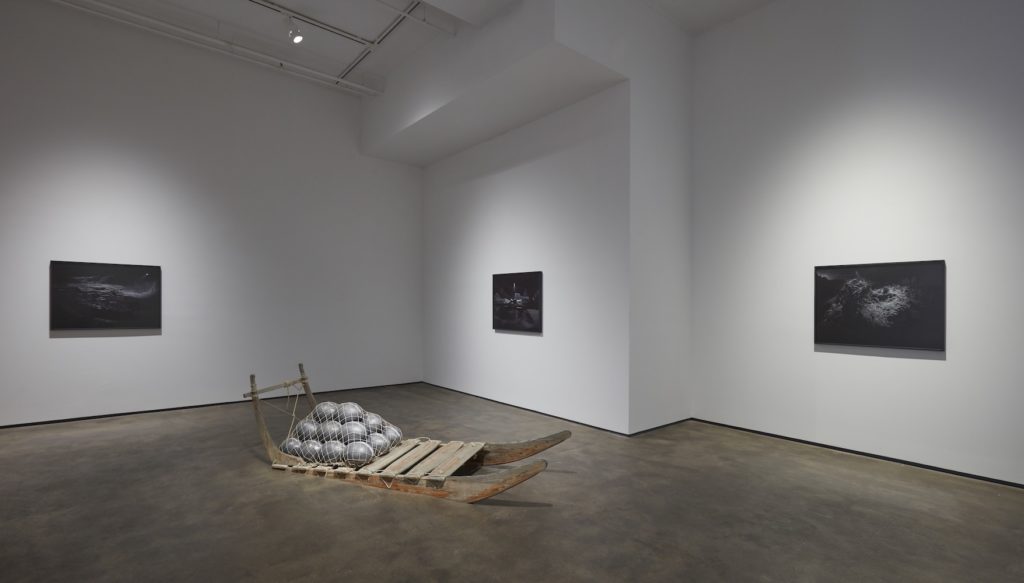
Installation shot of Julian Charrière’s “Towards No Earthly Pole,” Sean Kelly, 2020. Courtesy of Sean Kelly. Photo: Jason Wyche.
It’s also a very beautifully shot film. Is there a tension between the aestheticization and abstraction of these regions and their very unique and pressing geological concerns?
I don’t think so, because the video is about how we project ourselves onto a place. Because we see pictures of the Arctic melting every day, we block them out—we don’t have empathy for the place anymore. For me, [the video] was a way to show the dark side of the polar region, to give it a new voice.
People have talked about your work as “environmental art” or “climate change art.” But that doesn’t seem correct to me. Your work deals with ecological concerns on a more philosophical level.
I’m interested in environmental questions—we need to change our way of seeing and understanding our world if we want to be able to live on the planet in 100 years. But I’m not creating the work as a discourse about climate change. It addresses a lot of different questions about time and perception, about what we can learn from a place, how we’re reacting to our world.
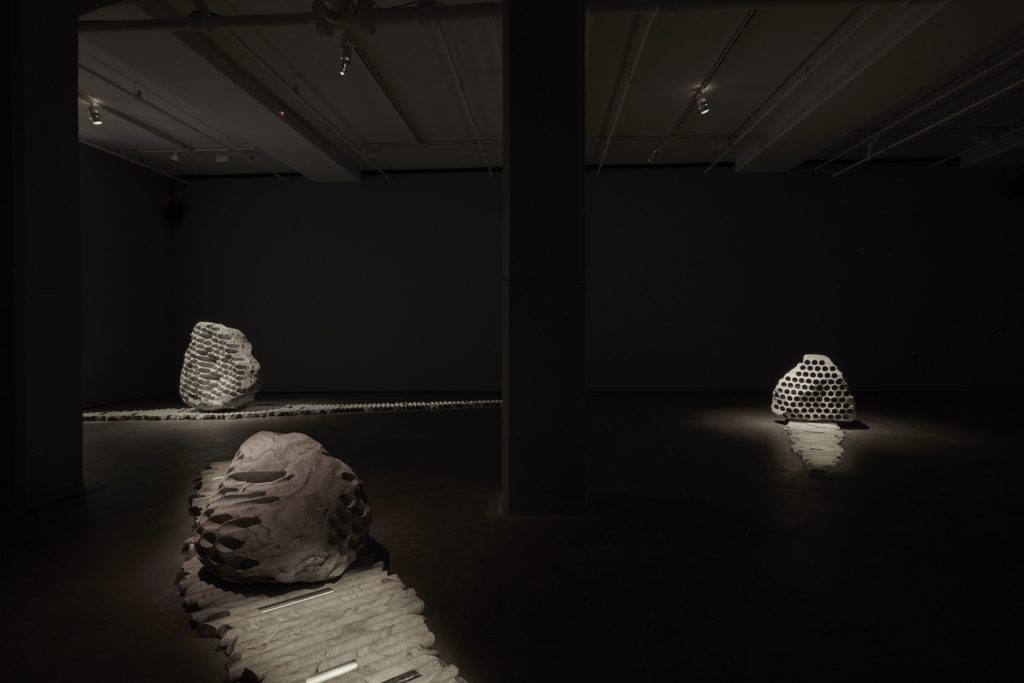
Installation shot of Julian Charrière’s “Towards No Earthly Pole,” Sean Kelly, 2020. Courtesy of Sean Kelly. Photo: Jason Wyche.
In the gallery, you relocate boulders to a new, unnatural context, much in the way that they were once displaced by large-scale, geological movement. It seems to me that by doing this, you’re commenting on how human industry has sped up natural phenomena to the point of provoking a climate crisis. With a piece like this, how do you negotiate the line between commenting on humanity’s role in climate change and perpetuating it yourself?
That’s the inequity of being a human being. We are ambivalent creatures—and I’m playing on that. These sculptures were first installed in a museum in Switzerland, which was not far from where the stones actually came from. They were moved with the last Ice Age and ended up in a valley far away. Obviously, there’s something interesting in the misplacement of these minerals, which look very static and very grounded, even if they don’t actually belong to that place.
Every time that I move them forward, it becomes a part of the story. It’s the same way that every time I create another hole in the stones, it will lessen the weight so they can move easier. Create enough holes and you might be able to carry them by hand. The idea was to give them a new trajectory. They were maybe waiting for the next Ice Age to move forward again. I changed that.
The places where the drill cores break were replaced by different metals that evoke ages of great expansion in human history—bronze, gold, copper. When we talk about the Anthropocene today, we’re talking about humans as the main force of movement. The work is not a critique of global movement, but in a sense, the erratics are now being moved by the art world: a new destiny and trajectory.
“Julian Charrière: Towards No Earthly Pole” is on view through March 21, 2020 at Sean Kelly Gallery in New York.












